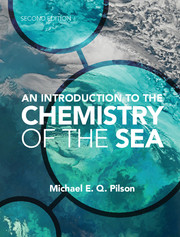Book contents
- Frontmatter
- Contents
- Preface
- Acknowledgments
- 1 Introduction
- 2 The water in seawater
- 3 Salinity, chlorinity, conductivity, and density
- 4 Major constituents of seawater
- 5 Simple gases
- 6 Salts in solution
- 7 Carbon dioxide
- 8 Nutrients
- 9 Trace metals and other minor elements
- 10 Radioactive clocks
- 11 Organic matter in the sea
- 12 Anoxic marine environments
- 13 Exchanges at the boundaries
- 14 Chemical extraction of useful substances from the sea
- 15 Geochemical history of the oceans
- Appendix A The chemical elements
- Appendix B Symbols, units, and nomenclature
- Appendix C Physical properties of seawater
- Appendix D Gases
- Appendix E Carbon dioxide
- Appendix F Dissociation constants and pH scales
- Appendix G Solubility of calcium carbonate
- Appendix H Effects of pressure
- Appendix I Radioactive decay
- Appendix J Geochemical reservoirs, and some rates
- Appendix K Sound absorption
- Epilogue
- Questions for chapters
- Glossary
- References
- Index
- Miscellaneous end matter
Questions for chapters
Published online by Cambridge University Press: 05 February 2013
- Frontmatter
- Contents
- Preface
- Acknowledgments
- 1 Introduction
- 2 The water in seawater
- 3 Salinity, chlorinity, conductivity, and density
- 4 Major constituents of seawater
- 5 Simple gases
- 6 Salts in solution
- 7 Carbon dioxide
- 8 Nutrients
- 9 Trace metals and other minor elements
- 10 Radioactive clocks
- 11 Organic matter in the sea
- 12 Anoxic marine environments
- 13 Exchanges at the boundaries
- 14 Chemical extraction of useful substances from the sea
- 15 Geochemical history of the oceans
- Appendix A The chemical elements
- Appendix B Symbols, units, and nomenclature
- Appendix C Physical properties of seawater
- Appendix D Gases
- Appendix E Carbon dioxide
- Appendix F Dissociation constants and pH scales
- Appendix G Solubility of calcium carbonate
- Appendix H Effects of pressure
- Appendix I Radioactive decay
- Appendix J Geochemical reservoirs, and some rates
- Appendix K Sound absorption
- Epilogue
- Questions for chapters
- Glossary
- References
- Index
- Miscellaneous end matter
Summary
[1] When a mixture of pure water and pure-water ice in a beaker is progressively frozen the temperature stays constant until all the water is frozen, while when a mixture of seawater and ice in a beaker is progressively frozen the temperature becomes colder and colder. Why is this?
[2] A small body of seawater is isolated from the ocean (perhaps by a growing sandbar in front of a lagoon). It is on average 5 m deep, and has a salinity of 35.00‰. It is winter and now the surface freezes; the ice thickness is 537.14 cm thick. What is the temperature of the bottom water in this lagoon? The density of ice is 0.9167 g mL–1.
[3] The worldwide rise in sea level is about 3 mm per year. Suppose this was all from melting ice, what volume of ice would have to melt each year to cause this rise?
[4] What is the salinity above which a vertically well-mixed body of water must cool all the way to the bottom before it can begin to freeze?
[5] In Table 2.2 there is the statement that 1 kg of seawater contains about 3.225 Ô 1025 molecules of water. Show how this was calculated.
[6] A sample of water is known to have an absolute ratio D/H = 120 Ô 10-6. What is the dD of this sample? Where does it seem likely that it could have come from (assuming somewhere in nature)?
- Type
- Chapter
- Information
- An Introduction to the Chemistry of the Sea , pp. 471 - 478Publisher: Cambridge University PressPrint publication year: 2012



